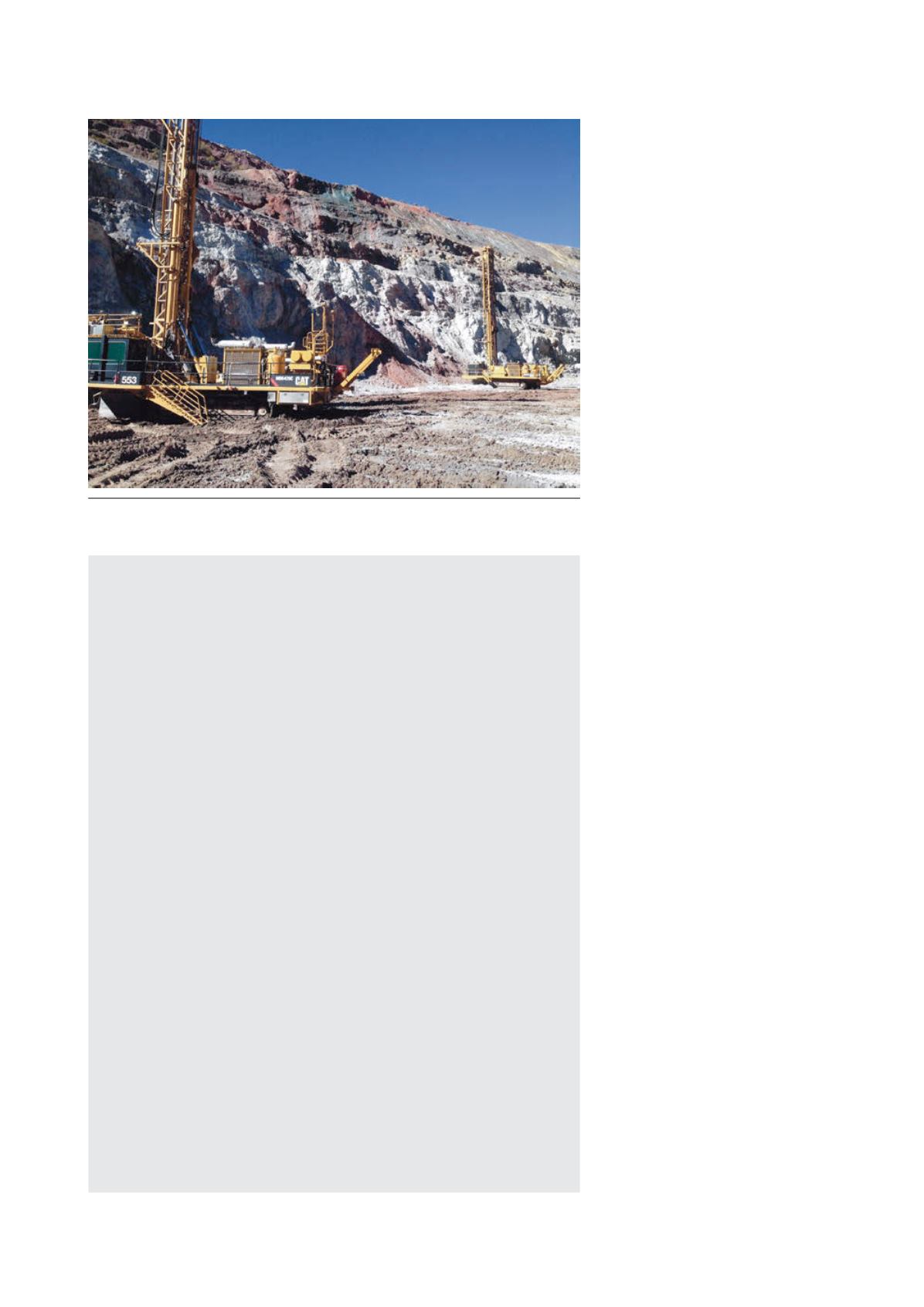
The MD6420C offers superior
technology and increased performance
to help the operation meet its
production goals on a site that presents
a number of challenges to the drill and
blast team – including difficult slope
designs, ground water, fault lines,
broken and fractured material plus
general ground stability issues.
The overwhelming response from
the drillers working with the new
drill fleet is that, while the original
MD6420’s are reliable and productive
workhorses, the new MD6420C – with
its computer controls, new operator
cab, and enhanced safety and service
features – is “by-far the absolute
best”. Productivity figures support
the operators’ conclusion.
Mine and drill fleet
details
Situated at an elevation of
approximately 1310.6 m (4300 ft), the
mine is an opencast operation, which
is approximately 340 m (1115 ft) deep,
1.5 km (4921 ft) wide, and 2.1 km
(6990 ft) long. There are dedicated
areas for maintaining large mining
equipment, mill/plant and offices for
employees, management, contractors
and suppliers.
The site’s two MD6420 rotary
blasthole drills, commissioned at the
site in 2012, are configured with a
low-pressure 2000 ft
3
/min./100 PSI
compressor, 16.5 m (54 ft) single pass
depth mast arrangement with 4-pod
pipe rack carousel to carry 193.6 mm
(7.625 in.) OD, 7.62 m (25 ft)
shoulder-to-shoulder pipe for
multi-pass drilling. The MD6420C is
also equipped with Cat Terrain, which
is connected to a CAN Bus processor,
for high‑precision positioning and drill
performance monitoring.
These production machines
perform tricone drilling with 250 mm
(9.875 in.) dia. holes down to
approximately 15.2 m (50 ft) hole
depth in a medium to hard copper
formation. The rotary drills are also
used to drill a zipper-blast row close to
the highwall. It is fired before the main
production blast to create a pre-split
that helps with highwall stability.
The MD6420C works alongside the
two MD6420 drills. As of
Cat technology – Single Pass Auto Drilling
Cat Single Pass Auto Drilling uses complex algorithms to adjust for optimal
penetration rates based on parameters entered by the driller. Because the
computer processor can detect minute changes in rotary drill torque,
pulldown force, bit air pressure and vibrations generated while drilling in just
a fraction of a second, it is able to calculate a defined response and adjust
accordingly to changing ground conditions and strata. Once the command is
given to the machine, this system, which is unique to Caterpillar, takes the
driller through the entire process of drilling a blasthole. The basic sequence of
the Cat Single Pass Auto Drilling system is outlined below:
1.
Lower bit to ground level.
2.
Ease into the hole collar, with choked air and water injection modulated.
3.
Once the hole has been successfully collared to a prescribed collar depth
and upon reaching competent ground, the system begins to drill the hole
by increasing air and modulating water, pulldown force and RPM/torque
to suit the condition encountered.
If the machine detects fallback or hits a void it goes into flushing
mode.
If the machine detects faults, joints or fractures, it will take action
to work past the obstacles and ensure it is not overfeeding or over
torquing, which can damage the drill bit.
4.
Upon reaching its defined hole depth, the machine then goes through a
flushing cycle to ensure all material is flushed out of the hole, and then it
retracts the drill string.
5.
If the defined hole depth requires more than a single pass, the drill string
will raise slightly, use air to flush the hole, then it will shut off blowing
air. The machine will wait for a second pipe to be added to the drill string
and then will resume drilling upon command.
6.
Once the drill string has been retracted (automatically for single pass or
manually for multi-pass) upon reaching the collar, the air will shut off and
the drill bit will raise into the dust hood. The machine is then ready for
the next command.
Two different generations of Cat MD6420 drills work side-by-side to prepare a bench
for blasting.
40
|
World Coal
|
June 2016


